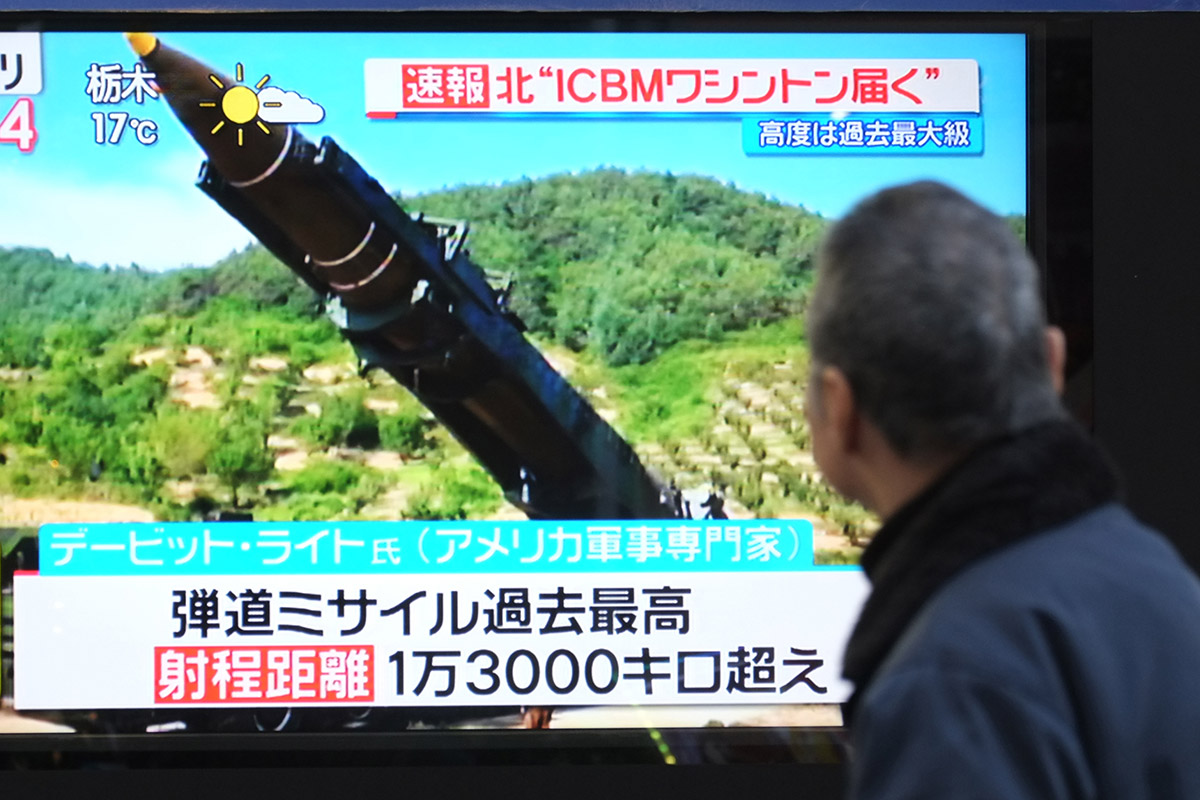North Korea shattered a two-month period of relative quiet by test-firing a missile that analysts say may put the US east coast in range.
Japan said the intercontinental ballistic missile flew for 53 minutes on a lofted trajectory and may have reached an altitude of more than 4,000 kilometers (2,500 miles) before landing in waters about 250 kilometers from its northwest coast. US Secretary of Defense James Mattis said that it flew higher than any previous North Korean launch.
US President Donald Trump, who has previously threatened “fire and fury” against Kim Jong Un’s regime, had a measured response, telling reporters that “we will take care of that situation.” The president spoke by phone with Japanese Prime Minister Shinzo Abe but didn’t discuss military options, Japan’s top government spokesman said. He also spoke with South Korean leader Moon Jae-in.
The launch demonstrated progress in North Korea’s quest to obtain the ability to strike the US with a nuclear weapon, a capability that Kim Jong Un has said he needs to deter an American invasion. Trump has threatened to use military force if necessary to stop North Korea’s nuclear threat.
South Korea’s military said it staged a “precision strike” missile exercise within minutes of the launch. Mattis said that response “made certain that North Korea understands they could be taken under fire by our ally.”
South Korean’s Moon called for dialogue, warning that matters could become “uncontrollable” if North Korea obtains a fully functional ICBM. “We should prevent a situation where North Korea threatens us with its nuclear arsenal based on misjudgment or the US considers a preemptive strike,” he said during a National Security Council meeting.
Investors shrugged off the missile strike after an initial reaction. The yen fell as much as 0.5 percent before paring losses. “People have got somewhat conditioned to some of these tests that we’ve seen,” said Mark Lister, head of private wealth research at Craigs Investment Partners in Wellington.
The US, Japan and South Korea requested an emergency United Nations Security Council meeting.
North Korea has several ways in which it could up the ante. Foreign Minister Ri Yong Ho suggested in September that Pyongyang could include testing a hydrogen bomb in the Pacific Ocean. The isolated state has also threatened to fire a missile near the US territory of Guam.
Launches of ballistic missiles from submarines or an ICBM on a flatter trajectory would show technical improvements.
South Korean Unification Minister Cho Myoung-gyon told reporters Tuesday that he didn’t rule out the possibility that North Korea declares the completion of its nuclear weapon development next year.
DC in Range
The Pentagon said the missile traveled about 1,000 kilometers before splashing down in the Sea of Japan.
“If the numbers we have on this latest test are accurate, then it looks like North Korea has just demonstrated Washington, DC and much of the US east coast is now within range,” said Shea Cotton, research associate at the James Martin Center for Nonproliferation Studies of Middlebury Institute of International Studies at Monterey.
North Korea doesn’t yet have the technological capability for its ballistic missiles to survive a return through the atmosphere, South Korea’s Cho said. Still, Pyongyang’s development of nuclear capabilities has been faster than earlier expected., and Seoul doesn’t rule out the possibility that North Korea declares completion of nuclear weapon development next year, he said.
Building a vehicle that can protect warheads from the heat and stress of a return flight – re-entry capability – is critical for developing functional intermediate-range and ICBMs.
Dialogue ‘Viable’
The launch ends a lull in test activity by the Kim regime. North Korea’s last provocation was on 15 September, when it fired a second missile over Japan in as many months.
Trump has stepped up efforts to isolate North Korea this year, seeking to curb its exports and other revenue-generating activities following previous ICBM launches. It has also pressured China and Russia to cut off economic activities with Kim’s regime, though both countries say they prefer dialogue.
China’s major news portals this morning downplayed the provocation. The timing was particularly awkward for North Korea’s only ally and main provider of economic support as it comes a week after President Xi Jinping dispatched a special envoy to Pyongyang on a four-day trip.
"It’s embarrassing for China," said Yang Xiyu, a former Chinese negotiator for the six-party talks on North Korean denuclearisation. "North Korea has been looking for opportunities to show the entire world that China has little leverage over the regime."
In recent weeks, the Trump administration has sent mixed signals to North Korea. On a trip to Asia earlier this month, Trump called on North Korea to “come to the table” to make a deal to end its nuclear program, while Secretary of State Rex Tillerson said he could envision talks with Kim’s regime as a precursor to formal negotiations.
Then on 20 November, Trump labeled North Korea a state sponsor of terrorism due to threats of nuclear devastation and support of terrorist acts including assassinations on foreign soil. North Korea called it a reminder that it should keep hold of its " precious nuclear sword.”
Tillerson said in a statement after Wednesday’s missile launch that “diplomatic options remain viable and open, for now.” – Bloomberg
Recommended stories:
